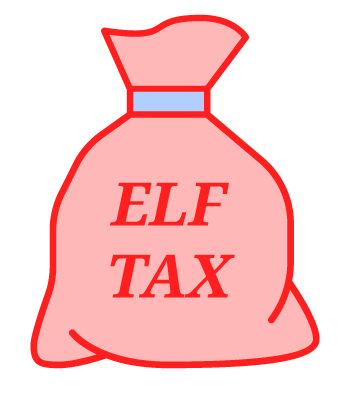


1. The Suit
A high-quality Santa suit – and we’re presuming you want to be a great-looking Santa – will run between $800 – $1200[i]. But that’s just the suit – the boots with the thick leather belt are going to cost another $200 – $400.
Some experts say you’ll need as many as 10 suits, but we’ll hope you can live with five and some regular laundering.
Total Santa Suit Cost = $7,500
[i] https://www.cnbc.com/2018/12/18/how-much-money-it-costs-to-be-santa-claus-and-how-much-you-can-make.html

2. The Kids
Nearly 33% of the world’s population is aged from 0-17, and as of December 2019, the world’s population is 7.8 billion people[i], which means there are 2.6 billion children.

2. The Toys
To comfortably avoid being called a Grinch, each child should receive a toy with a budget (excluding labor) of $10.00, which would make our production and materials cost equal $26 billion.
Total Materials & Production Cost (Without Labor) = $26 Billion/Year.
2. The Reindeer
With feed, veterinary and reindeer-related ranch maintenance costs, expect each reindeer to cost about $2,000 every year[i]. Since there are nine reindeer (we’re including Rudolph), that’s $18,000 every year – but we should consider herd growth and attrition (Rudolph had Clarice[ii] to give him some company on those long winter nights, and we’d assume the other reindeer would need that attention, too).
Let’s say the herd is actually 18 reindeer in size, which will cost $36,000 a year.
*Note: Reindeer live about 15 years[iii], and Rudolph was first chronicled in 1939, so Rudolph VI will actually be leading the sleigh in 2019.
Total Reindeer Cost = $36,000/Year
[i] https://careertrend.com/how-to-start-a-reindeer-farm-13640547.html

2. The Elves
In order to make toys for over 2.5 billion kids, you’re going to need a large, dedicated staff. Given Buddy The Elf’s toy production, we know elves are required to make around 1,000 toys a day[i], so given a normal work year with PTO and holidays, a staff of 10,000 elves would be sufficient.
Compensation: Food, Room & Board

Elf Housing
As part of his compensation package, Santa feeds and houses the elves. Rent in Anchorage is typically around $1200/month for a one bedroom apartment, but in smaller communities, rent is around $800/month. We’d expect rent at the North Pole to be on the lower end, so we’ll figure housing to run Santa about $96 million a year.
Total Elven Housing Cost = $96 Million/Year

Elf Food
Shopping for food in Alaska is more expensive than in the lower 48 states. The recommended minimum amount of food for one person is $451.71 a month, significantly higher than the national average.
We will discuss elven families later – but this calculation assumes we’re feeding a single elf, and not his family, which could include great-great-great-great-great-great-great grandchildren, or great-great-great-great-great-great-great-great grandchildren, if they live to their full 750-year life expectancy. If he’s feeding each member of his staff, Santa’s shelling out around $54 million a year in food.
Total Elven Food Cost = $54 Million/Year
Compensation: Wages, 401(k), Health Insurance

Elf 3% 401(k) Match
Santa has already set up his 401(k), something he’d do with Tom Parks in our 401(k) services department. There are set up fees, advisory costs, and a fiduciary duty he has to his elves – all demands that Tom and his department would walk Santa through.
In terms of matching the elves’ 401(k) contributions, Jack Hauser, a member of the Annex Wealth Management financial planning team, says “Using $7.25hr (fed/wi) at 2,080 hr/yr, you get an annual income of $15,080. At a 3% match would cost Santa $452.40/elf, and at 10,000 elves would be $4,524,000. But luckily that’s tax deductible for Santa’s business.”
Total Elven 401(k) Match = $4.5 Million/Year

Elf Health Insurance
Elvencare (the North Pole’s version of Medicare) is a bureaucratic nightmare and is generally not discussed in polite company as it typically leads to temper tantrums and broken toys.
If Santa pays the average annual health insurance cost per person in Alaska for his staff of elves, he’d pay about $51 million a year.
Total Elven Health Insurance Cost = $51 Million/Year
We spoke with Randy Winkler, CFP®, the head of our Financial Planning department, about how Elves might navigate retirement. If you or any members of your family are an elf, make sure to pass these valuable thoughts along:

Because of their long lifespans (approximately 750 years), Elves don’t reach Full Retirement Age until they turn 625 years old. They can take social security as early as 620 or wait until 640 to get their maximum benefit.

Because of their extremely long lifespans, Long Term Care is very expensive but many Elves have it because they don’t want to be a burden on their children, grandchildren, great grandchildren, great-great grandchildren, great-great-great grandchildren, great-great-great-great grandchildren, great-great-great-great-great grandchildren, great-great-great-great-great-great grandchildren, great-great-great-great-great-great-great grandchildren, or great-great-great-great-great-great-great-great grandchildren.

Santa, like many employers back in the day, used to provide a pension for the Elves. He has since frozen the pension (for retiring Elves Annex recommends choosing the pension option over the lump sum option due to the 12% payout ratio) and all Elves employed over the last 20 years have been auto-enrolled in the Claus Enterprises 401k.

Santa has a 3% match and is very excited by the new Roth-401k option. The age-based funds in the plan are not to be believed! New employees typically take select the Vanguard 2500 fund (unless they are receiving guidance from their WM with a well allocated portfolio).

Tax planning at the North Pole is different as well. Due to the low wages but long investment time horizons the Elves have only 3 income tax brackets, 10%, 25%, and 50%. Roth conversions are huge as the Elves hope to avoid the higher tax brackets (especially when they reach RMD age of 700 and because of their gigantic IRA balances).

Whole Life Insurance is not available for Elves (it would be cost prohibitive) but term insurance is available (250 year term is very popular).

Annuities are non-existent at the North Pole. No insurer is willing to take on the risk of paying out for 500 years.

Thanks to the bull market many Elves have been able to retire early. There is a thriving retirement community in a tree in Keebler, Florida.
Jill Martin, Annex Wealth Management’s Estate Planning Attorney, had these thoughts for elves looking at planning their estate:

Estate planning for up to 9 generations creates more Generation Skipping Transfer Tax Exempt Dynasty Trusts in the North Pole than all the corporate trustees in the world could administer.

As a result, I’d recommend forming “North Pole Trust Co” to manage expectations for all the “trust fund” Elves and ensure they continue to be productive members of North Pole society.

I’d recommend that Santa take the opportunity to raise tax revenue to make Elvencare more functional by enacting a Rule Against Perpetuities ending future use of Dynasty Trusts resulting in more estate tax revenue at every couple generations as opposed to never.
As always, Annex Wealth Management’s initial consultation is free, so Santa and the elves paid nothing to receive unbiased advice from financial experts.

Total Cost = $26,355,543,500/year
*If you’re wondering how Santa pays for this extraordinary outlay each year? Santa, who’s immortal, has been saving for a very long time. He has worked with advisors he can trust to determine just how much of a nest egg he needs for every kid to have a toy.
In Santa’s case, our planners figure he’ll need a nest egg of about $440 billion ($439,259,058,333 to be precise) – which, assuming a 6% rate of return, yields enough to bring joy to kids on Christmas morning.